-

人教版新目标初中英语九年级下册Could you please tell me where the restrooms are教案
Step Ⅰ RevisionCheck homework. Ask a few students to read the article in 3a.Then ask a few students to read their guides.Step Ⅱ Part 1Look at the words in the box. Ask a student to read them. Make sure the students understand the meaning of the words. You are to fill in the blanks with the words. In some cases, students may need to use another form of the word, for example adjusting for tense or subject/ verb agreement.Ask students to fill in the blanks on their own.Check the answers. Step ⅢPart 2Go through the instructions with the class.Look at the example with the students.Ask students what the answer would be.Ask a student to read the question and answer it.Excuse me, could you tell me where the bank is, please?The bank is across the street from the shopping malt.Get students to complete the work in pairs.Check the answers. Ask a few students to read their questions.Step Ⅳ Just for Fun!Ask all the students to read the conversation. Ask: What is funny about this cartoon? Help students to explain. A Martian is a person from the planet Mars.There is no such thing as Martian food on Earth, and the clerk looks silly because he is trying to think of where there is a Martian restaurant.Invite some pairs of students to present this conversation to the rest of the class.Step Ⅴ Summary and HomeworkIn this class, we’ve done much writing practice using the key vocabulary words and the target language presented in this unit. After class, please finish the questions in 2 in your exercise books. Then finish the exercises on pages 47~48 of the workbook as well.The Seventh Period Ⅰ Teaching Aims and Demands1. Knowledge Objects(1) Key Vocabularyimage, adventure, jealousy, hero, crime, journey, brave, no longer, show interest in, take it easy, become interested in, plain looks(2)Text:Grown-ups like cartoons, too.2. Ability Objects(1) Fast-reading to get a general idea of the text.(2) Careful-reading to get the detailed information in the text.

人教版新目标初中英语九年级下册I’ll help clean up the city parks教案
Talk about offering help (P60)I’ll help clean up the city parks.A: I’d like to work ...B: You could help ...Talk about ways to tell people about the Clean-Up Day (P61)We need to ...We can’t ...I’ll ...Talk about the work the volunteers do (P62)These three students all volunteer their time to help other people.Somebody loves to ... / helps ... / plans to ... / wants to ...A: What do you like doing?B: I like ... A: What kind of volunteer work do you think I could do?B: You could ...1. 重点词汇advertisement, fix, repair, pleasure, blind, deaf, shut, carry, specially, fetch2. 认读词汇hunger, homeless, cheer, clean-up, sign, establish, major, commitment, elementary, veterinarian, coach, similar, call-in, strategy, disabled, organization, unable, support, appreciate, donation, part of speech, pronoun, adverb, preposition, conjunction, donate, Jimmy, Sally3. 词组clean up, cheer up, give out, put off, set up, think up, take after, fix up, give away, put up, hand out, work out, at once

人教版新目标初中英语七年级下册Don’t eat in class教案2篇
Don’t fight. =You can’t fight. (板书,教读)教师把这些句子板书在黑板上,并请学生大声整齐地读祈使句和“can’t”句型,并让学生注意两种句型表达形式的不同和转换,“Don’t …=You can’t…”;并对学生说:These are our school rules. (板书,教读) You can’t break the school rules. Don’t break the school rules.(板书,教读)步骤3 :Practicea. T: Now, each of the students is breaking one of these rules.Please finish 1a.学生看图,完成1a的内容,检查答案并大声朗读校规。b. 听录音,完成1b,选出四位学生都违反了哪条校规;听之前,学生要读会英文名。c. 请两位学生朗读1c部分的句型;要求学生两人一组对话表演,SA扮演外校转来新生,SB告知本校校规。(学生可经过讨论,多说出他们想到的校规,不必只限于书上;教师应给予帮助)2) 第二课时(2a~4)步骤1 :warming up of revisionT: What are the rules at your school?学生使用“can”或祈使句表达各条校规;其中老师可引出“eat in the cafeteria outside”的表达。步骤2 :Practicea.T: Christina is an exchange student. She doesn’t know the rules. Let’s listen, what activities they’re talking about?学生听第一遍时,完成2a;第二遍时,完成2b;b. 请学生领读2c部分,看着2a完成的表格,理解2c活动的要求;分成小组针对2a进行问答;

人教版新目标初中英语七年级下册I ’d like some noodles教案
教学过程Step 1: warming-up Sing a song---------“food and drink” Step 2: Revision1 Dictation2 Revise: What kind of noodles would you like?I’d like …What size bowl of noodles would you like?I’d like…Step 3: Presentation1 show pictures of food, ask students say the words.2 Students read the newspaper ad in 3a. Fill in blanks with words in the box. Then read the ad together, the teacher explains some difficult language points.3 Check the answers Step 4 PracticeAsk students to finish 3b in the same way according to 3a. Students read the short passage and fill in the blanks .At last, check the answers.Step 5 productionAsk students to write their own ad for dumplings, noodles, drinks, and other foods they know. Then ask students to read their partner’s ad. Then order food and drink from their partner.Step 6 Home workGroup work – make an ad about “food and drink”

人教版新目标初中英语七年级下册Where is your pen pal from教案
2.1Match the country with the language.Step II Reading3a? let the students read the letter fast and answer the questions.? Let the students ask more questions about the letter as possible as the can.Step III Writing3b.Step IV. Pairwork2cStep V Listening2a, 2bStep V. HomeworkExercises book(1) P3Exercises book (2) P3Period FourStep I . Dictate the words and sentences in Unit1.Step II. Self-checkStep III. Check the answers for Exercises book in the unit.Step IV. Home workRevise and preparation for unit 2.教学反思:通过本单元的学习,学生基本可以谈论人们的国籍,居住城市及其所说的语言,通过书信方式去介绍自己并寻找笔友。但在涉及到国外的一些城市时,学生对这方面的知识相对欠缺,能介绍的城市并不多,也反应出学生课前预习不充分,这跟学生学习条件也有关,大多数学生无法通过网络获取所需信息。因此,在以后的教学中要多指导学生通过计算机网络获取信息,拓宽知识面。

人教版新目标初中英语七年级下册What do you think of game shows教案
五、教学Section B-2c1. Pair work: What do you think of the belt/sunglasses/…? What does your father/mother/… think of your scarf/belt…?2. Group work(1). Teacher shows some different kinds of school uniforms (制服)and asks : “ What do you think of your school uniforms? If you have a chance to choose your school uniforms, what kind would you like to choose?”(2). Discuss in groups.(3).Get some Ss to report in class.说明:这一步旨在让学生运用已有的语言知识谈论对事物的看法和意见,并简单阐明理由,培养学生的主动思维能力和运用英语的能力。六、教学拓展调查电视节目的收视率任务:调查你周围的人对现在各种电视节目的反响。活动过程:1.教师布置任务,让学生调查周围的人(包括他的亲戚朋友和邻居)喜欢收看哪方面的电视节目。2.学生进行调查活动,运用本单元所学的句型What do you think of….? (Why?)What's your favorite game shows?What do you think of talk show?I doesn’t mind it.I like it.I love it.I can’t stand it.3.记录下排在前10位的TV Program,填写调查表,比较其收视率。

人教版新目标初中英语七年级下册Where did you go on vacation教案
句型: Where did you go on vacation? I went to summer camp.Did she go to Central Park?Yes,she did.No, she didn’t语法:一般过去时特殊疑问句、一般疑问句及肯、否定回答。课时安排4课时第一课时:Section A:la,1b,lc,2a,2b,2c 第二课时:Section A:3a,3b,4第三课时:Section B:1,2a,2b,2c第四课时:Section B:3a,3b,3c,4 and Self Check第一课时教学目标掌握描写假期生活的形容词。假期里自己所做事情的简单表达。谈论假期做的事情及当时情况。谈论假期时旅游的天气,旅游者以及食物等。教学过程一、导入播放一首英文歌曲:Let’s travel 说明:通过让学生听节奏欢快迪斯尼英语歌曲Let’s travel.引入本节课谈论的话题vacation and travel. 让歌曲使学生的思维活跃,增强课堂气氛,激发学生提高学习英语的兴趣。T:How is the trip ?Ss : It’s pretty good/ happy/exciting /relaxing/busy/dangerous/ fantastic说明:这个问题是为了操练形容词。建议让多个Ss作答。鼓励他们用不同的形容词。上述个别形容词本应在第二课时中出现,但可以在warming-up中第一次非正式出现。这些形容词也可在老师的评价语中适时出现,以加深学生对词汇的印象。

人教版新目标初中英语八年级下册Have you ever been to an amusement park教案
(1)Have you ever been to …? Yes, I have. / Yes, I have ever been to …No, I haven’t. / No, I have never been to …(2)When did you go there? I went there last year. (3)I have never been to a water park. Neither have I. I have ever been to an amusement park. So have I. (4)How long have you been studying English? I’ve been studying English since nine o’clock. I’ve been studying English since I came back home. I’ve been studying English for five hours. (5)What’s that? It’s an amusement park in Japan. I’ve never been to an amusement park like it before. It’s fun to learn another language. Let’s go tonight. Isn’t this great?space museum, amusement park, water park, South America, Peru, Holland, European culture, tour guide, flight attendant, musical instrument, more than, be from, get to, take lessons, neither, discover, graduate, change

人教版新目标初中英语八年级下册It’s a nice day, isn’t it教案2篇
"Hello! Welcome to English class! Introduce yourself. Meet your new classmates." That's what the teacher says. What do you say? "Oh no!" It can be difficult talking to new people. But it can be fun, and you can make friends. How do you do it? Make small talk. Small talk is polite conversation. "Wang Nan is a great pingpang player, isn't she?" "I'd love to meet her, wouldn't you?" "It's been raining a lot, hasn't it?" Tag questions are a form of polite speech. To make small talk successfully, you should know how to make them. You should also know what topics to talk about. Try to learn this unit carefully. The next time you're in English class, you'll find out. Making small talk's easy, isn't it? (“你好!欢迎你!请做一下自我介绍。认识一下你的新同学。”通常在课上老师会这样说。你会说什么呢?“噢,不!”与陌生人谈话太困难了。但是这也很有意思,并且你还能交到朋友。你该怎么做呢?闲聊。闲聊指得是礼貌的对话。“王楠是一个很棒的乒乓球运动员,不是吗?”“我希望自己能认识她,你呢?“今年的雨水很多,不是吗?”反意疑问句是一种礼貌用语。为了使得谈话成功,你应该知道怎样去进行闲聊。你还应该知道与不同的人该谈论什么样的话题。认真的学习这个单元吧,下次在英语课上,你会发现与大家展开谈话是一件很容易的事情,不信我们来试试。)

人教版新目标初中英语九年级下册We’re trying to save the manatees教案2篇
本单元主要围绕着有关濒临灭绝的动物这一话题,学习了应该怎样保护我们的环境,以及就某一问题展开辩论。目标提示语言目标能够运用所学知识,就某一问题展开辩论。认知目标1、复习一些语法:现在进行时、一般现在时、用used to 表示一般过去时、现在完成时、一般过去时的被动语态。2、学会表达同意和不同意。3、学会以下基本句型:We’re trying to save the manatees.Manatees eat about 100 pounds of food a day.There used to be a lot of manatees.In 1972,it was discovered that they were endangered.Some of the swamps have become polluted.情感目标了解一些濒临灭绝的动物的生活习性和濒临灭绝的原因,教育学生应该如何保护环境。教学提示充分利用多媒体等教学设备,创设与本课话题相关的情境,如各种不同种类的动物、动物园以及有关环境的画画等等。围绕着本单元的教学目标,设计一些贴近学生实际的教学任务,如让学生谈论自己最喜欢的动物,如何拯救濒危动物,如何保护环境等等。让学生根据所学知识,就动物园是否对动物有利以及其他的话题进行辩论。

人教版新目标初中英语九年级下册You’re supposed to shake hands教案
教学目标:1. 掌握本单元一些重点词汇的写法和用法。2. 学会自如谈论餐桌礼仪。Step 1 RevisionAsk some students to retell the customs at the table in France in the passage in 3a.Step 2 Self checkPart 1. Fill in each bland with the correct word given. Students do the exercises by themselves at first. Then check the answers. Ask the students to comprehend the sentences and help them point out uses of some words, like “arrive (at / in) sw., spend time / money on sth , spend time / money (in) doing sth.”Part 2. Read about Fan Ling’s experience in a western restaurant. Understand the passage. Point out some key points in the passage.1. be / get used to doing sth. 习惯做某事2. begin with = start with 以….开头3. crowd v. 挤满,塞满 the crowd 人群 crowded adj. 拥挤的Then students discuss about how she would solve her problem. Ask some to share their stories with others.Part 3. Complete the crossword by looking at the sentences on the left. Then check the answers.
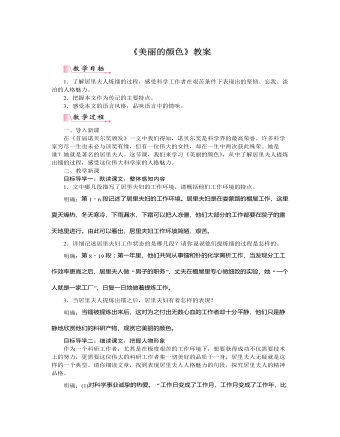
部编版语文八年级上册《美丽的颜色》教案
目标导学二:细读课文,把握人物形象作为一个科研工作者,尤其是在极度艰苦的工作环境下,想要获得成功不仅需要技术上的努力,更需要这位伟大的科研工作者集一切美好的品质于一身,居里夫人无疑就是这样的一个典型。请你细读文章,找到表现居里夫人人格魅力的句段,探究居里夫人的精神品格。明确:(1)对科学事业诚挚的热爱。“工作日变成了工作月,工作月变成了工作年,比埃尔和玛丽并没有失掉勇气。这种抵抗他们的材料迷住了他们。”其中的“迷住”一词突出表现了居里夫人对科学的痴迷和挚爱。(2)无惧一切困难,敢于将想法付诸实践。“最困难的,或者说几乎不可能的,乃是离析这极小含量的物质,使它从与它密切混合着的杂质中分离出来。”居里夫人选择最困难的工作,付出艰苦的劳动。(3)持之以恒、不轻言放弃。“工作日变成了工作月,工作月变成了工作年。”在这日复一日、年复一年的工作中,居里夫人终于提炼出了镭。
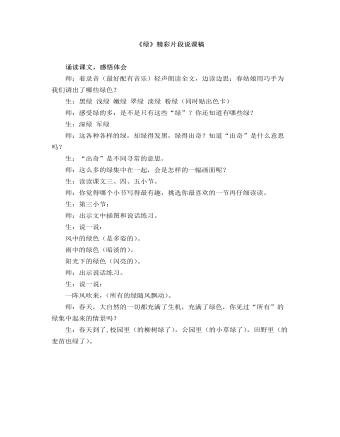
部编人教版四年级下册《绿》精彩片段说课稿
诵读课文,感悟体会师:着录音(最好配有音乐)轻声朗读全文,边读边思:春姑娘用巧手为我们调出了哪些绿色?生:黑绿 浅绿 嫩绿 翠绿 淡绿 粉绿(同时贴出色卡)师:感受绿的多:是不是只有这些“绿”?你还知道有哪些绿? 生:深绿 军绿 师:这各种各样的绿,却绿得发黑,绿得出奇?知道“出奇”是什么意思吗?生:“出奇”是不同寻常的意思。师:这么多的绿集中在一起,会是怎样的一幅画面呢?生:读读课文三、四、五小节。
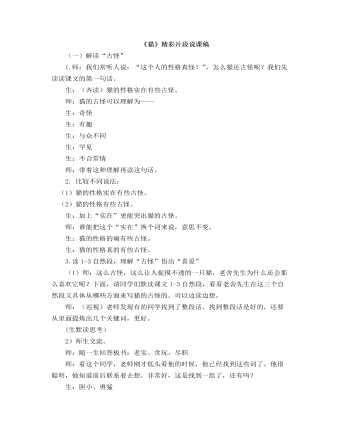
部编人教版四年级下册《猫》精彩片段说课稿
师:在幼儿园的时候,老师摸着小朋友的头说:“小朋友,乖——”回到家的时候,爷爷奶奶亲孙子,亲的了不得了:“宝贝儿,乖——”那现在,老舍先生说猫乖,你怎么看。生:老舍先生对猫的喜爱。师:那好,把你体会到的这个词写到上面来。(师指引学生把“乖”写在“勇猛”的右下角)同学们,这是我们读书读出来的。同学们,是不是我们这样去读句子,这样去读书,就更进一步了呢?这是有关“老实”的,你能不能再找找“贪玩”的有关句子?生:它要出去玩,一天一夜,任凭谁怎么呼唤也不回来。师:“任凭谁怎么呼唤,它也不肯回来”,想想看,老舍先生的家里,会有谁,用什么办法来呼唤猫?生:老舍先生师:假如你是老舍先生,你怎么用鱼来呼唤猫回来?生:猫儿,回来吧,这里有新鲜鱼等着你呢。生:还有老舍的妈妈。师:我先不跟你讨论老舍的妈妈是不是还活着。谁再来。生:还有小猫的老婆。师:换个说法,小猫的——生:小猫的老伴说,来,老婆,回来呀,和我一起去旅游。
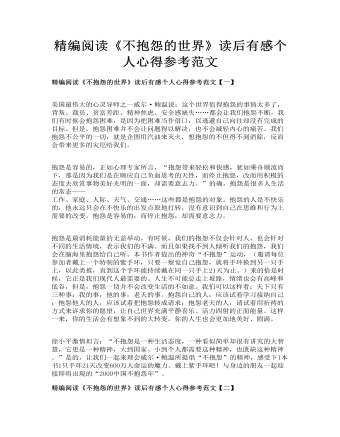
精编阅读《不抱怨的世界》读后有感个人心得参考范文
抱怨是容易的,正如心理专家所言,“抱怨带来轻松和快感,犹如乘舟顺流而下,那是因为我们是在顺应自己负面思考的天性,而停止抱怨,改而用积极的态度去欣赏事物美好光明的一面,却需要意志力。”的确,抱怨是很多人生活的常态——工作、家庭、人际、天气、交通……这些都是抱怨的对象。抱怨的人是不快乐的,他永远只会在不快乐的出发点原地打转,没有意识到自己在思维和行为上需要的改变。抱怨是容易的,而停止抱怨,却需要意志力。
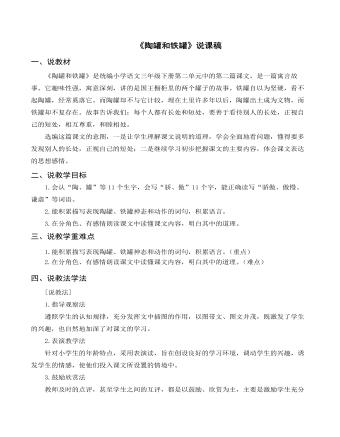
(说课稿)部编人教版三年级下册《 剃头大师》
三、说教学重难点1.能积累描写表现陶罐、铁罐神态和动作的词句,积累语言。(重点)2.在分角色、有感情朗读课文中读懂课文内容,明白其中的道理。(难点)四、说教法学法[说教法]1.指导观察法遵照学生的认知规律,充分发挥文中插图的作用,以图带文、图文并茂,既激发了学生的兴趣,也自然地加深了对课文的学习。 2.表演教学法 针对小学生的年龄特点,采用表演读,旨在创设良好的学习环境,调动学生的兴趣,诱发学生的情感,使他们投入课文所设置的情境中。 3.鼓励欣赏法 教师及时的点评,甚至学生之间的互评,都是以鼓励、欣赏为主,主要是激励学生充分地展示才能,满足他们希望得到赞许,体会成功的心理特点,激起学生学习的欲望,增强朗读的信心。
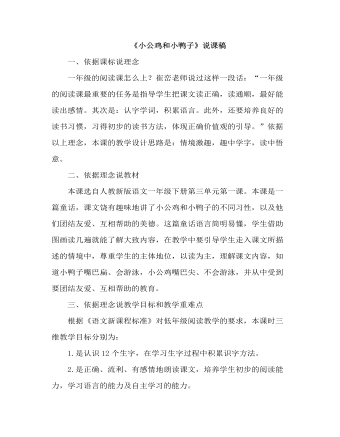
部编人教版一年级下册《小公鸡和小鸭子》(说课稿)
三、依据理念说教学目标和教学重难点根据《语文新课程标准》对低年级阅读教学的要求,本课时三维教学目标分别为:1.是认识12个生字,在学习生字过程中积累识字方法。2.是正确、流利、有感情地朗读课文,培养学生初步的阅读能力,学习语言的能力及自主学习的能力。3.巩固识字的方法,体会朗读的方法。4.从课文中受到要团结友爱、互相帮助的教育四、说说学生一年级学生具有天真活泼,好奇好问,好模仿易感染的心理特点,容易被直观形象、新鲜活动的事物所吸引,并能在教师创设的情境中获得体验,达到情感共鸣、因此在教学中,我根据学生的身心特点设计情境,设计游戏,分解朗读要求,分散识字难点,让学生在一堂课中能始终学得轻松,学得愉快。五、说说教学策略方法1、 创设情境法。创设故事情境,让学生切身投入到情境中去。2、 趣味识字法。用赛读排火车等方法巩固识字。3、 以读促悟法。指导朗读,边读边悟。

部编人教版一年级下册《小公鸡和小鸭子》说课稿
一、教学要求1、会写7个生字。2、会认13个字。3、正确、流利、有感情地朗读课文。通过朗读课文,知道鸭子和公鸡的不同习性,懂得小伙伴之间要互相帮助。二、教材说明本课是一篇童话。讲的是小公鸡跟小鸭子一起玩,小公鸡给小鸭子捉虫子吃,小鸭子给小公鸡捉鱼吃。小公鸡下河后差点被淹死,幸亏小鸭子救了它。课文饶有趣味地讲了小鸡和小鸭的不同习性,以及它们团结友爱、互相帮助的美德。三、教学建议(一)教学准备准备本课的生字词语卡片、放大的课文插图、多媒体课件及朗读课文的录音带。(二)识字、写字教学学习生字。重点指导读准“他、河、说”和要求会认的字“块、捉”的音。
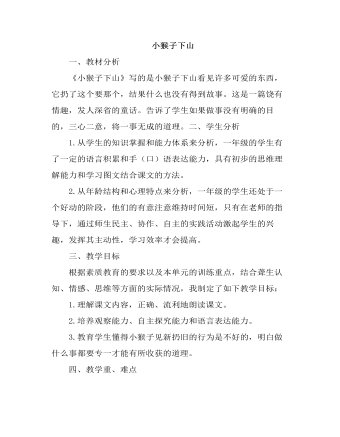
部编人教版一年级下册《小猴子下山》(说课稿)
三、教学目标根据素质教育的要求以及本单元的训练重点,结合聋生认知、情感、思维等方面的实际情况,我制定了如下教学目标:1.理解课文内容,正确、流利地朗读课文。2.培养观察能力、自主探究能力和语言表达能力。3.教育学生懂得小猴子见新扔旧的行为是不好的,明白做什么事都要专一才能有所收获的道理。四、教学重、难点本课的关键是必须处理好形象的图和抽象的文字之间的关系,因为只有图文紧密结合了,才能使学生了解小猴子活动的顺序和事物之间的联系,从而有效的发展学生的语言和思维。五、说教法、学法1.教法结合学生的个体差异和不同的学习需求,依据本课故事性强,画面丰富,结构类似的特点,我主要采取了以下教学方法:(1)图文结合的情景教学法。(2)以扶为主的扶放教学法。(3)读思结合的品读感悟法。
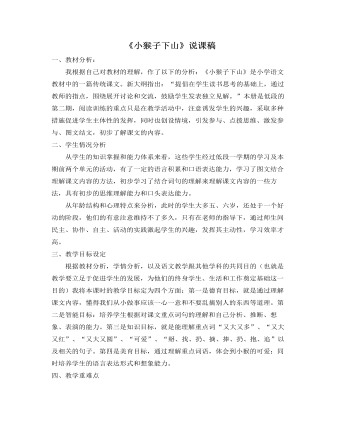
部编人教版一年级下册《小猴子下山》说课稿
二、学生情况分析从学生的知识掌握和能力体系来看,这些学生经过低段一学期的学习及本期前两个单元的活动,有了一定的语言积累和口语表达能力,学习了图文结合理解课文内容的方法,初步学习了结合词句的理解来理解课文内容的一些方法,具有初步的思维理解能力和口头表达能力。从年龄结构和心理特点来分析,此时的学生大多五、六岁,还处于一个好动的阶段,他们的有意注意维持不了多久,只有在老师的指导下,通过师生间民主、协作、自主、活动的实践激起学生的兴趣,发挥其主动性,学习效率才高。三、教学目标设定根据教材分析,学情分析,以及语文教学跟其他学科的共同目的(也就是教学要立足于促进学生的发展,为他们的终身学生、生活和工作奠定基础这一目的)我将本课时的教学目标定为四个方面:第一是德育目标,就是通过理解课文内容,懂得我们从小做事应该一心一意和不要乱摘别人的东西等道理。第二是智能目标:培养学生根据对课文重点词句的理解和自己分析、推断、想象、表演的能力。第三是知识目标,就是能理解重点词“又大又多”、“又大又红”、“又大又圆”、“可爱”、“掰、找、扔、摘、捧、扔、抱、追”以及相关的句子。第四是美育目标,通过理解重点词语,体会到小猴的可爱;同时培养学生的语言表达形式和想象能力。